27 Six Batteries of Change – Unleashing Organisational Energy
The Six Batteries of Change framework was developed by Professor Peter De Prins and colleagues from the Vlerick Business School in Belgium.1 This evidence-based model suggests that organisational energy is required across a range of formal and informal areas within an organisation for ongoing high performance. The model also says that a balance of strategic and operational considerations must be front of mind in achieving success and driving transformation and change.
These batteries of change are relevant to all kinds of organisations. The metaphor of energy coming from a range of ‘batteries’ provides a straight-forward yet robust frame for diagnosis of your current organisational landscape and a way of targeting key initiatives to move the organisation forward towards positive transformation.
How do you think this metaphor of energy for change might work in the context of Army?
To help you answer this question, here is a range of diagnostic questions in relation to the Six Batteries of Change for you to explore.
As you make your way through these questions keep the Six Batteries of Change diagram (below) in mind. It will help you to see the connections between the various pieces.
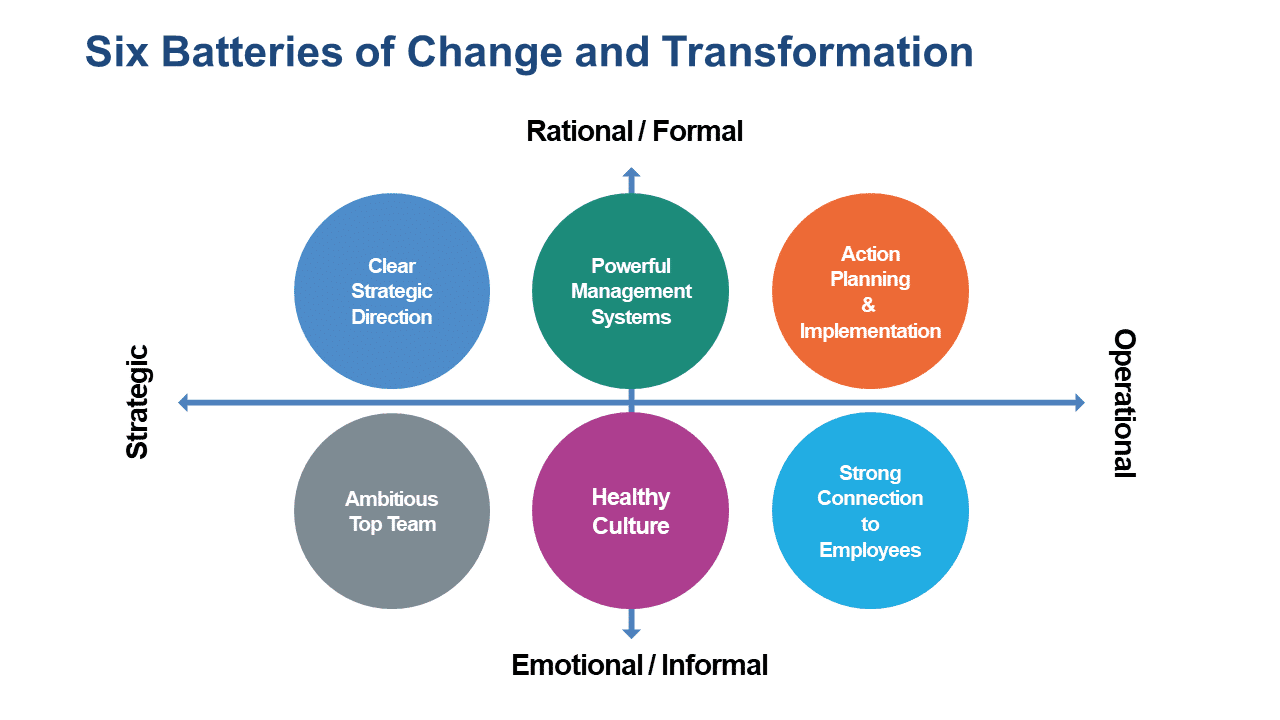
If it makes things easier for you, you can also download and print a copy of the Six Batteries of Change diagram. You can do this by downloading the file below.
This change model and the batteries concept is important to you in this unit as it will help you with your @Work activities. This is because your @Work 2 activity asks you to identify a workplace challenge that you want to explore. Along the way in this unit we will refer back to the Batteries of Change and suggest to you how the metaphor is useful to you in your work and thinking.
Take a good look at the Batteries of Change diagram. The Batteries are clustered into ‘Rational/Formal’, the top row of the diagram and ‘Emotional/Informal’, the bottom row of the diagram. You will also notice that the left hand end of the diagram is about the strategic components of the organisation and the right hand end is more about the operational end of the organisation. Because of this arrangement of the diagram you can pay more attention to the relevance to your role and your situation in the Army.
Let’s have a look at each of the Batteries in turn.
Firstly, the Rational/Formal Batteries.
These Batteries are about how the organisation goes about getting things done.
Having a clear sense of purpose and a well-developed strategy is critical in making sure that everyone in the Army is working towards the same goals. This is particularly important when we want to make change ‘stick’. The desired change or changes need to align to the Army’s purpose and strategy.
Use the diagnostic below to consider your context. (Click the image to enlarge.)
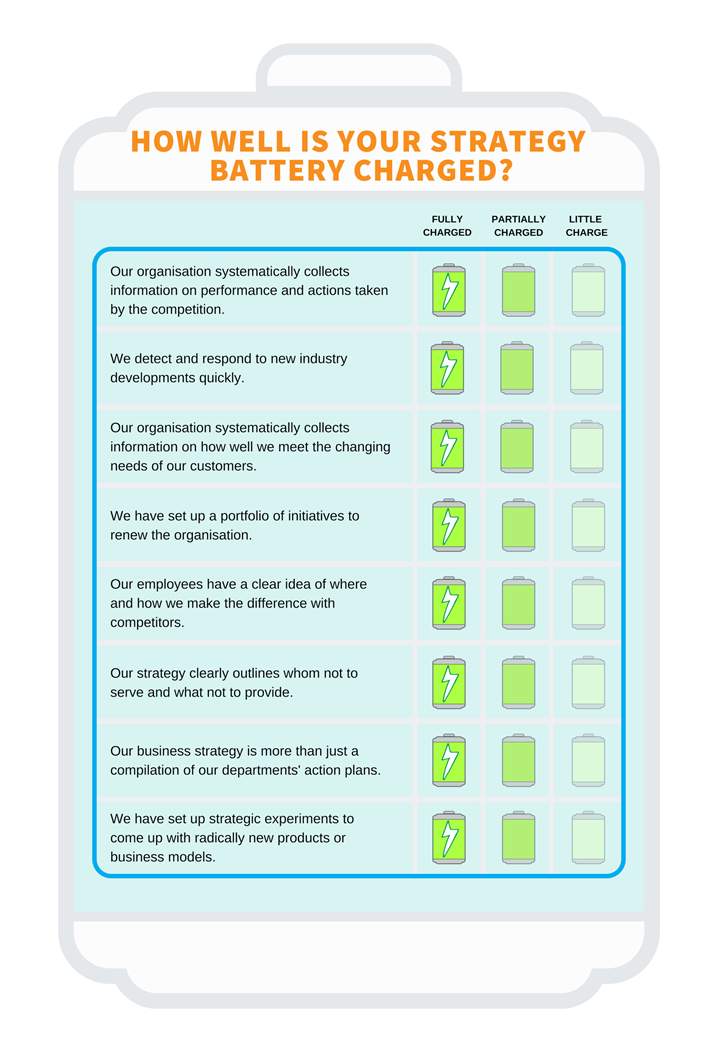
This battery is where the connections between a great strategy and great execution happen. Considering the range of programs and projects that you may want to deliver, how well do the Army’s structures and systems help to deliver across the Army?
Use the diagnostic below to consider your context. (Click the image to enlarge.)
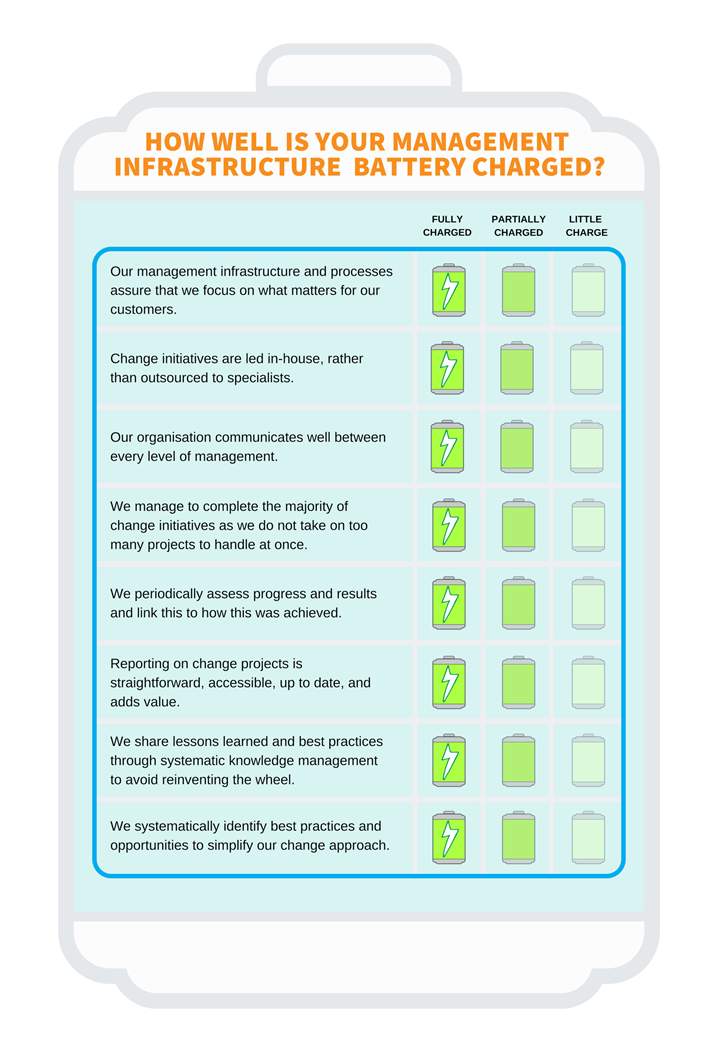
It will be impossible to achieve effective change without good reliable processes, strong problem solving and excellent change management. This is where strategy is translated into clear benefits for the Army that will improve its overall organisational capability.
Use the diagnostic below to consider your context. (Click the image to enlarge.)
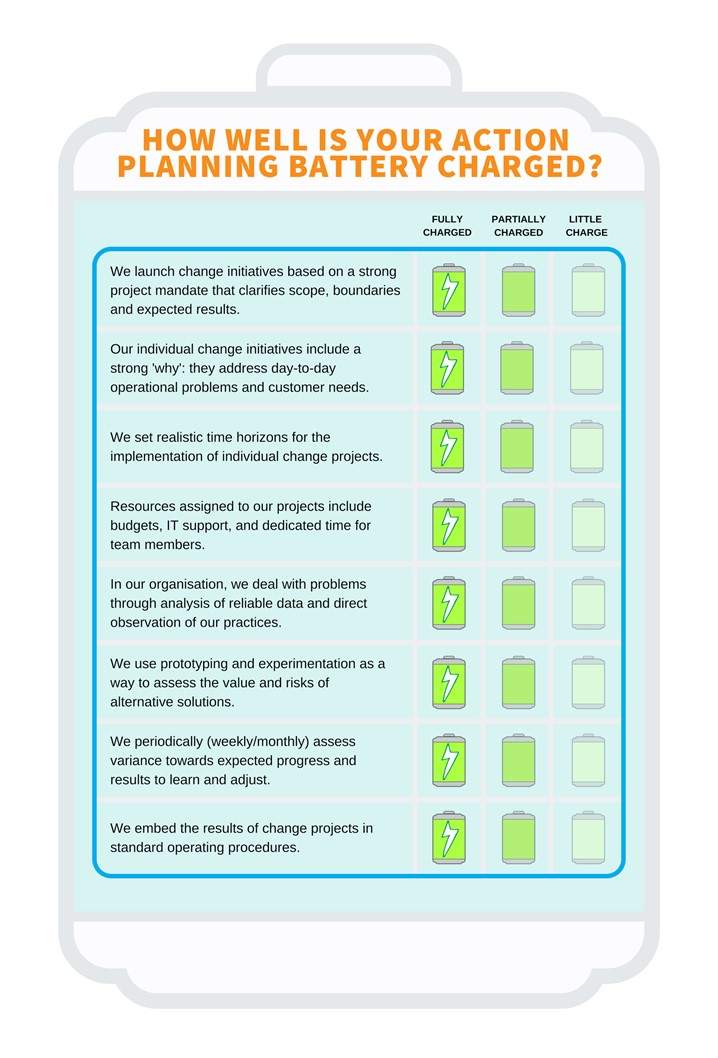
Next the Emotional/Informal Batteries.
These Batteries are about the nature of organisation and its ways of working.
The most important source of energy across the Army is its leadership team. Without the energy of leaders at all levels, change will be difficult to achieve. Leaders need to set ambitious goals and aspirations. They need to speak in a way that demonstrates their solidarity as a group.
Use the diagnostic below to consider your context. (Click the image to enlarge.)
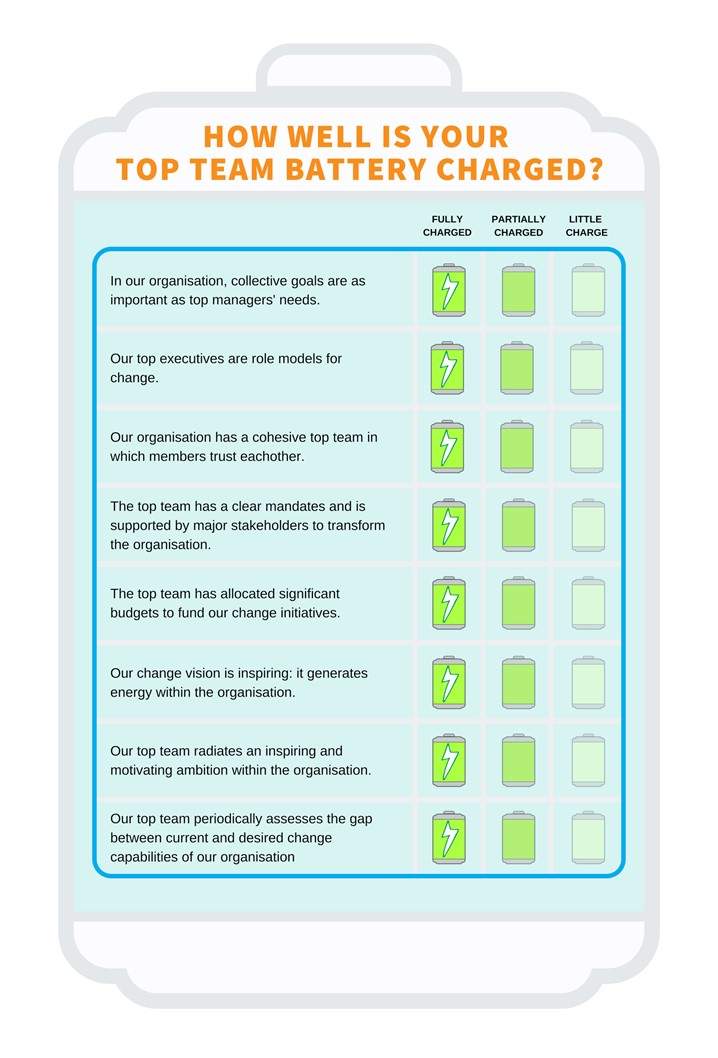
A healthy culture is critical for positive change, no matter how large or small the new ideas are that you wish to implement. For the Army to achieve traction in achieving positive change and innovation the culture must be open, collaborative and receptive to new ideas. People must see the Army values in action at all levels.
Use the diagnostic below to consider your context. (Click the image to enlarge.)
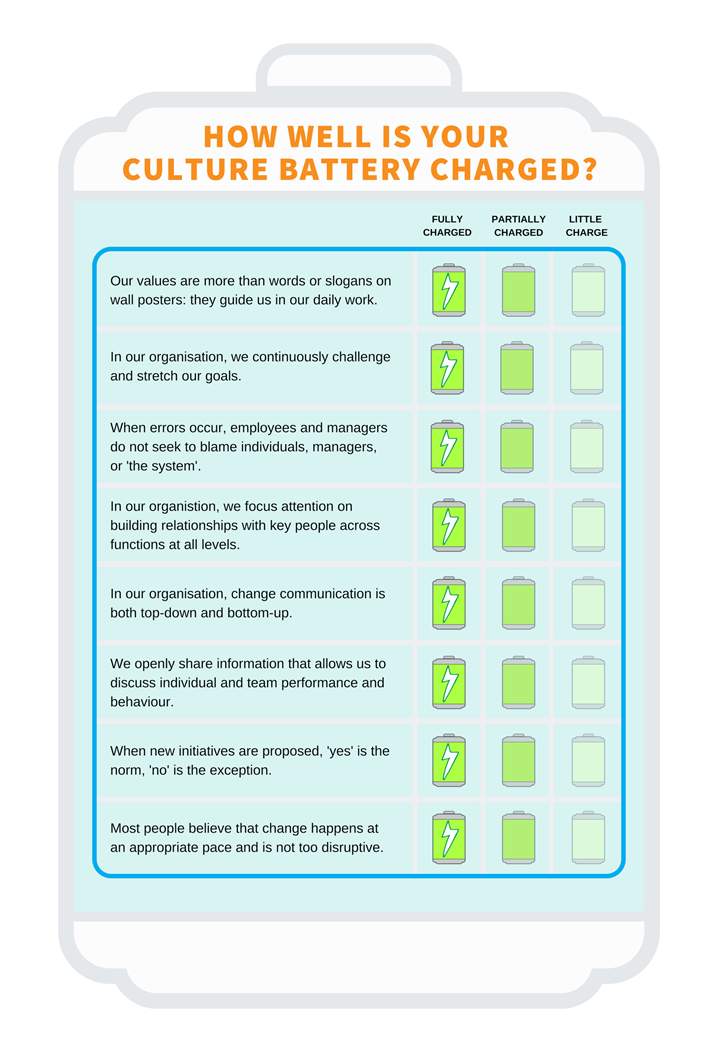
Embedding change requires people to commit. What are the ways in which you need to engage deliberately with people from across Army to ensure they feel connected and engaged?
Use the diagnostic below to consider your context. (Click the image to enlarge.)
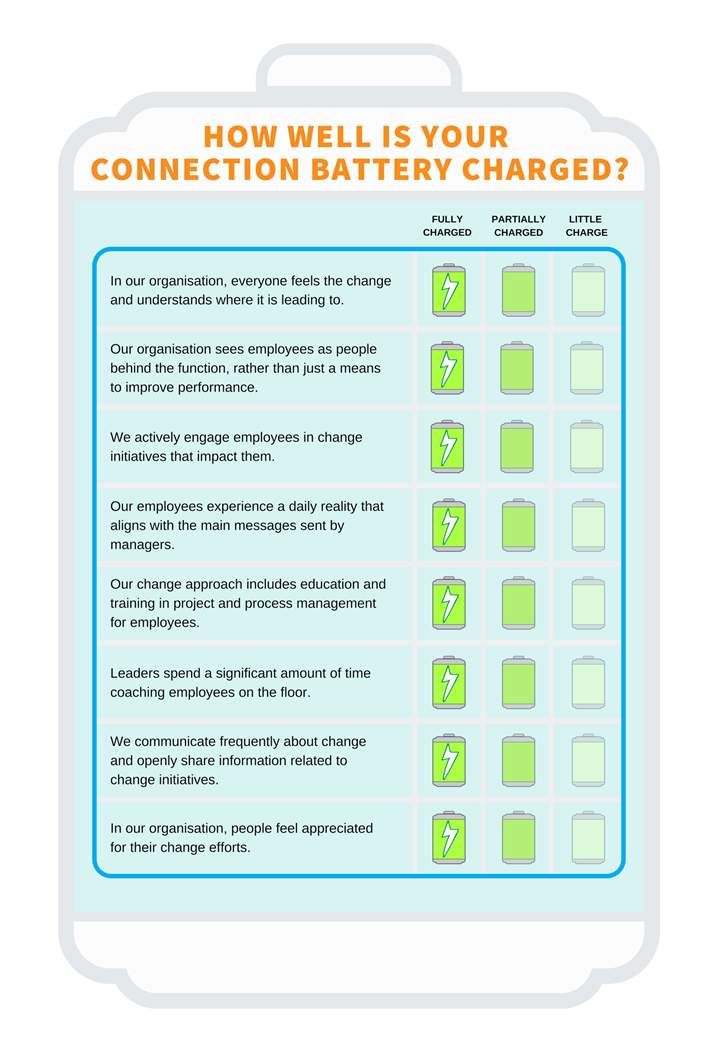
Now that you have read about the Batteries of Change, we want you to do an audit of how you believe things are around you at the Army. You can consider the Army as a whole, or you might want to think of your more immediate environment such as your barracks or the field.
As you do the audit keep in mind that you aren’t critiquing the Army or your immediate environment. You are thinking about ‘how you find things around you’.
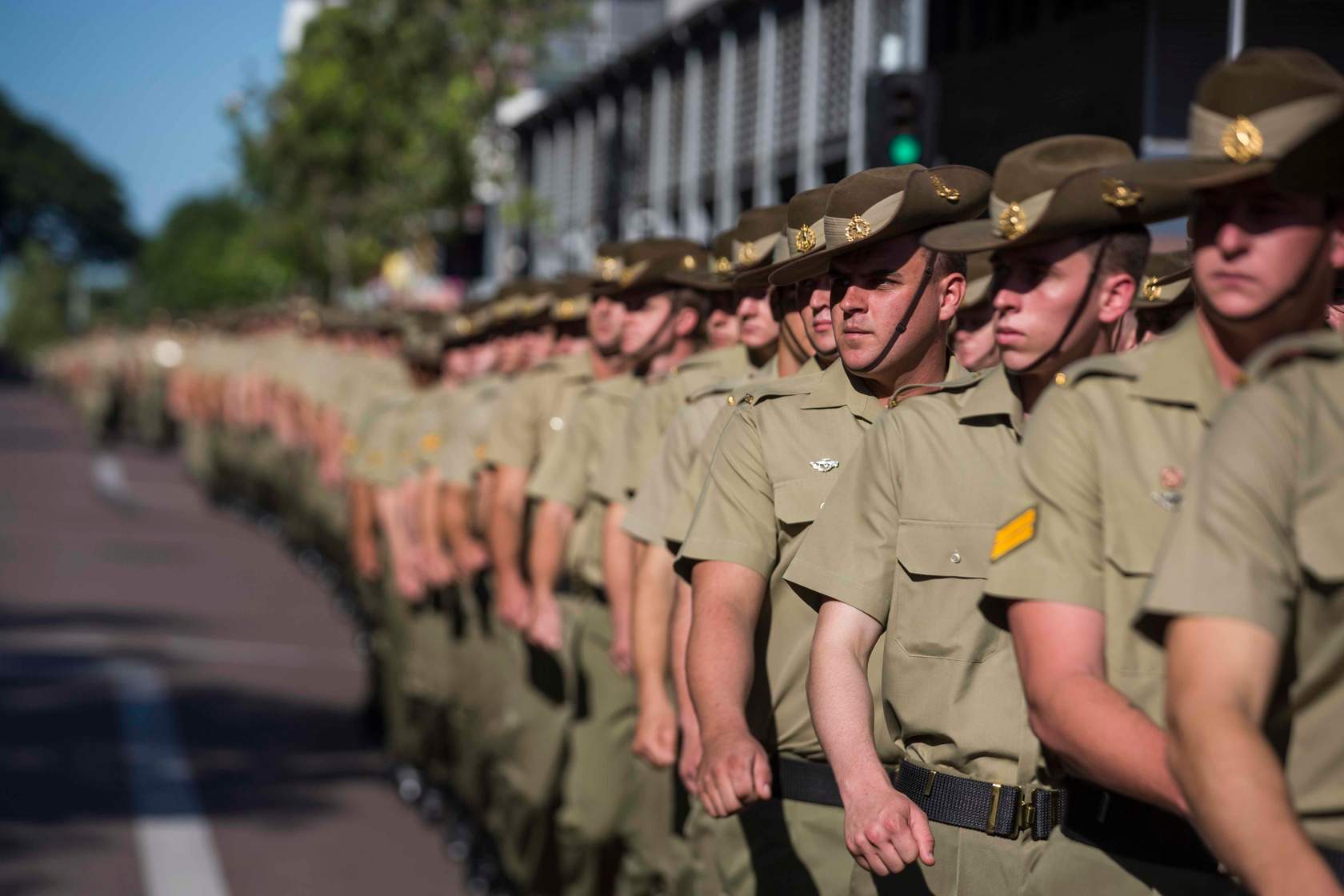
Activity: the Army’s Energy for Change
In this activity you are going to have a go at diagnosing where Army is at in terms of Energy for Change.
In the table below you will find the key elements of each of the Batteries of Change. Read these carefully and think about the overall patterns that you can see in the table. Make a mental note of what you think things are like in the each of the Battery areas.
Each of the six batteries highlight key actions and activities to generate energy that will support transformation.
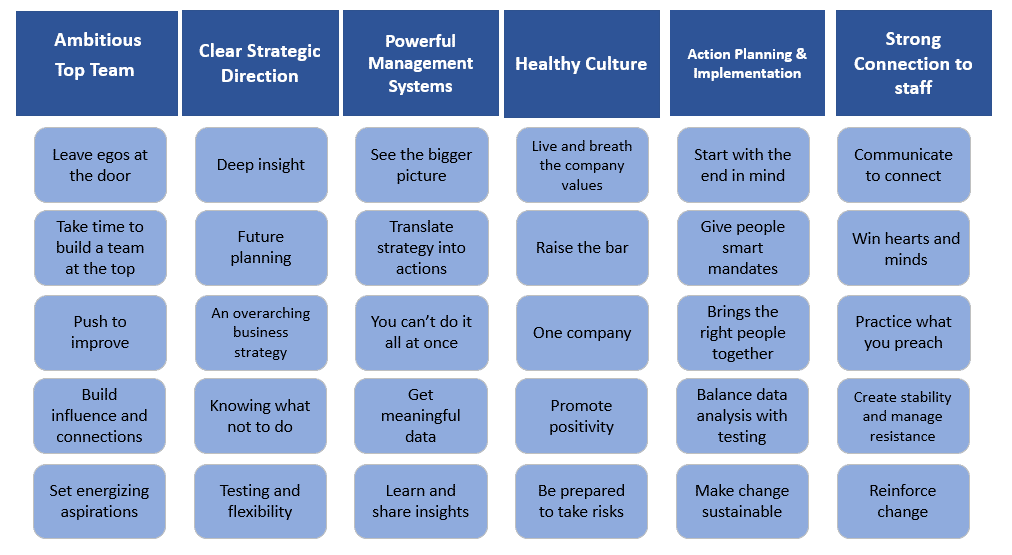
Adapted from De Prins et al (2018) Six Batteries of Change. Vlerick Business School Press.
You have only just started working on the Batteries of Change. However, you have probably already started to develop some ideas around the things that will support you when you come to developing and implementing a change initiative in your team or other place in the Army.
References
- De Prins, P., Letens, G., & Verweire, K. (2017). Six batteries of change. Lannoo Publishers.
Six Batteries of Change – Unleashing Organisational Energy
The Six Batteries of Change framework was developed by Professor Peter De Prins and colleagues from the Vlerick Business School in Belgium.1 This evidence-based model suggests that organisational energy is required across a range of formal and informal areas within an organisation for ongoing high performance. The model also says that a balance of strategic and operational considerations must be front of mind in achieving success and driving transformation and change.
These batteries of change are relevant to all kinds of organisations. The metaphor of energy coming from a range of ‘batteries’ provides a straight forward yet robust frame for diagnosis of your current organisational landscape and a way of targeting key initiatives to move the organisation forward towards positive transformation.
The framework considers that the more energy available to an organisation across key dimensions, the better positioned the organisation is to achieve transformation and success.
How do you think this metaphor of energy for change might work in the context of Army?
To help you answer this question, here is a range of diagnostic questions in relation to the Six Batteries of Change for you to explore.
Six Batteries of Change: Source: Adapted from De Prins, P., Letens, G., & Verweire, K. (2017). Six batteries of change. Lannoo Publishers; Page 21.
As you make your way through these questions keep the Six Batteries of Change diagram in mind. It will help you to see the connections between the various pieces.
This change model and the batteries concept is important to you in this unit as it will help you with your @work activities. This is because your @work 2 activity asks you to identify a workplace challenge that you want to explore. Along the way in this unit we will refer back to the Batteries of Change and suggest to you how the metaphor is useful to you in your work and thinking.
The Batteries are clustered into ‘Rational/Formal’, the top row of the diagram and ‘Emotional/Informal’, the bottom row of the diagram. You will also notice that the left hand end of the diagram is about the strategic components of the organisation and the right hand end is nore about the operational end of the organisation. Because of this arrangement of the diagram you can pay more attention to the relevance to your role and your situation in the Army.
__________________________________________________________
Let’s have a look at each of the Batteries in turn.
Please add in each of the diagnostic pictures for each battery – or the ‘from -to slides. Which ever make most sense. they are available in the Rise assets location. Also I am sure there is a great way to make this all look “Jenny” GREAT!
Firstly, the RATIONAL/FORMAL Batteries
These Batteries are about how the organisation goes about getting things done.
The CLEAR STRATEGIC DIRECTION Battery
Having a clear sense of purpose and a well-developed strategy is critical in making sure that everyone in the Army is working towards the same goals. This is particularly important when we want to make change ‘stick’. The desired change or changes need to align to the Army’s purpose and strategy.
The POWERFUL MANAGEMENT SYSTEMS Battery
This battery is where the connections between a great strategy and great execution happen. Considering the range of programs and projects that you may want to deliver, how well do the Army’s structures and systems help to deliver across the Army?
The ACTION PLANNING AND IMPLEMENTATION Battery
It will be impossible to achieve effective change without good reliable processes, strong problem solving and excellent change management. This is where strategy is translated into clear benefits for the Army that will improve its overall organisational capability.
Next the EMOTIONAL / INFORMAL BATERRIES
These Batteries are about the nature of organisation and its ways of working.
The AMBITIOUS TOP TEAM Battery
The most important source of energy across the Army is its leadership team. Without the energy of leaders at all levels, change will be difficult to achieve. Leaders need to set ambitious goals and aspirations. They need to speak in a way that demonstrates their solidarity as a group.
The HEALTHY CULTURE Battery
A healthy culture is critical for positive change, no matter how large or small the new ideas are that you wish to implement. For the Army to achieve traction in achieving positive change and innovation the culture must be open, collaborative and receptive to new ideas. People must see the Army values in action at all levels.
The STRONG CONNECTION WITH EMPLOYEES Battery
Embedding change requires people to commit. What are the ways in which you need to engage deliberately with people from across Army to ensure they feel connected and engaged?
______________________________________________________-
Now that you have read about the Batteries of Change we want you to do an audit of how you believe things are around you at the Army. You can consider the Army as a whole, or you might want to think of your more immediate environment such as your barracks or the field.
As you do the audit keep in mind that you aren’t critiquing the Army or your immediate environment. You are thinking about ‘how you find things around you’.
Activity:
Diagnosing where Army is at in terms of Energy for Change. [the ppt can be pulled about and turned into something else or it might just work like this[
In the table above you will find the key elements of each of the Batteries of Change. Read these carefully and think about the overall patterns that you can see in the table. Make a mental note of what you think things are like in the each of the Battery areas.
You have only just started working on the Batteries of Change. However you have probably already started to develop some ideas around the things that will support you when you come to developing and implementing a change initiative in your team or other place in the Army.


